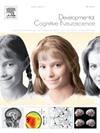ASD男性的社会行为:认知灵活性、工作记忆和功能连接偏差之间的相互作用。
IF 4.9
2区 医学
Q1 NEUROSCIENCES
引用次数: 0
摘要
自闭症谱系障碍(ASD)在表现上是高度异质性的。虽然在自闭症男性中一直观察到大脑功能连接异常,但自闭症症状不同领域的神经生物学基础尚不清楚。在这项研究中,我们评估了功能连接偏差的个体差异是否映射到ASD男性的社会行为。利用自闭症脑成像数据交换(Autism Brain Imaging data Exchange,简称ABIDE)的神经成像数据,我们对非asd男性儿童时期(n = 321)的网络间静息状态功能连接(rsFC)的规范轨迹进行了建模。然后将这些标准图表应用于ASD男性(n = 418),以计算反映rsFC非典型程度的个体偏差分数(z分数)。默认模式网络(DMN)、腹侧注意网络(VAN)、额顶叶网络(FPN)和躯体运动网络(SMN)之间的rsFC模式偏差与社会行为的不同维度相关。认知灵活性和工作记忆在VANxDMN z-得分与社会行为问题之间起中介作用。我们的研究结果强调了规范模型在个体水平上识别非典型大脑连接的潜力,揭示了与ASD社会行为问题相关的神经生物学模式,这对精确诊断和干预至关重要。通过瞄准认知灵活性和工作记忆,ASD男性的社会结果可能会得到改善。本文章由计算机程序翻译,如有差异,请以英文原文为准。
Social behavior in ASD males: The interplay between cognitive flexibility, working memory, and functional connectivity deviations
Autism spectrum disorder (ASD) is highly heterogeneous in presentation. While abnormalities in brain functional connectivity are consistently observed in autistic males, the neurobiological basis underlying the different domains of autism symptoms is unclear. In this study, we evaluated whether individual variations in functional connectivity deviations map to social behavior in ASD males. Using neuroimaging data from the Autism Brain Imaging Data Exchange (ABIDE), we modeled normative trajectories of between-network resting-state functional connectivity (rsFC) in non-ASD males across childhood (n = 321). These normative charts were then applied to ASD males (n = 418) to calculate individual deviation scores (z-scores) that reflect the degree of rsFC atypicality. Deviations in rsFC patterns among the default mode network (DMN), ventral attention network (VAN), frontoparietal network (FPN), and somatomotor network (SMN) were associated with distinct dimensions of social behavior. Cognitive flexibility and working memory mediated the association between VANxDMN z-scores and social behavioral problems. Our findings underscore the potential of normative models to identify atypical brain connectivity at an individual level, revealing the neurobiological patterns associated with social behavioral problems in ASD that are critical for precision diagnosis and intervention. Social outcomes in ASD males may be improved by targeting cognitive flexibility and working memory.
求助全文
通过发布文献求助,成功后即可免费获取论文全文。
去求助
来源期刊

Developmental Cognitive Neuroscience
NEUROSCIENCES-
CiteScore
7.60
自引率
10.60%
发文量
124
审稿时长
6-12 weeks
期刊介绍:
The journal publishes theoretical and research papers on cognitive brain development, from infancy through childhood and adolescence and into adulthood. It covers neurocognitive development and neurocognitive processing in both typical and atypical development, including social and affective aspects. Appropriate methodologies for the journal include, but are not limited to, functional neuroimaging (fMRI and MEG), electrophysiology (EEG and ERP), NIRS and transcranial magnetic stimulation, as well as other basic neuroscience approaches using cellular and animal models that directly address cognitive brain development, patient studies, case studies, post-mortem studies and pharmacological studies.
 求助内容:
求助内容: 应助结果提醒方式:
应助结果提醒方式:


